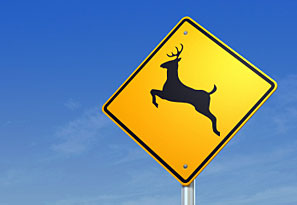Sharing the road with deer can be hazardous to your health. Each year many drivers and their passengers are injured or killed in collisions involving deer. While many wild animals cross roadways, deer present the most frequent hazard. As rural areas continue to develop and deer populations continue to increase, vehicle-deer crashes will continue to increase.
With the threat of collisions with deer ever present, drivers and their passengers must be properly restrained in safety belts to help avoid serious injury. While deer collisions happen year-round, the majority of collisions occur during the Fall, when deer are in their mating season and hunting season is open, and in the Spring, during birthing season. The times of highest risk for collisions are around dusk and sunrise. Remember, safety belts are the best defense in any collision.
To help avoid collisions with deer, the following defensive driving tips should be followed:
- Be especially alert for deer in the Fall and Spring, and around sunrise and sunset.
- Watch for “deer crossing” signs as they are posted where deer have been known to cross the roadway.
- Don’t depend on mechanical devices, such as deer whistles; tests indicate that they do not work.
- Maintain a safe speed; don’t overdrive your headlights.
- Use your high-beams, when there is no oncoming traffic, to help visibility.
- Scan the sides of the road to spot deer.
- If you see one deer, expect that others are nearby – deer are herd animals and rarely travel alone.
- If you see a deer on the road, slow down and blow your horn. Flashing your headlights may confuse the deer.
- If deer are on the side of the road, assume they will bolt out in front of you and drive slowly past them.
- Don’t try to swerve to avoid hitting a deer. Abruptly turning the vehicle may make you lose control and result in a more severe accident than hitting the deer.
If you do collide with a deer, you should take the following steps, if possible:
- Turn on your emergency flashers.
- Move your vehicle off the traveled portion of the roadway.
- Contact the police to report the collision.
- Do not go near the deer unless you are sure it is dead, as it may become violent if it is scared or injured.
- If the deer is in the roadway, only try to remove it if you are sure it is safe to do so.

